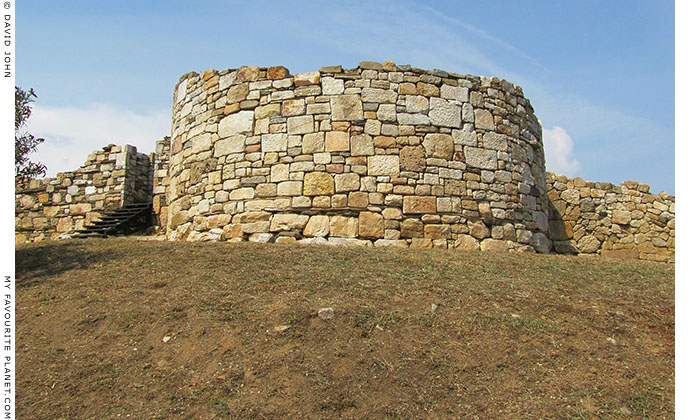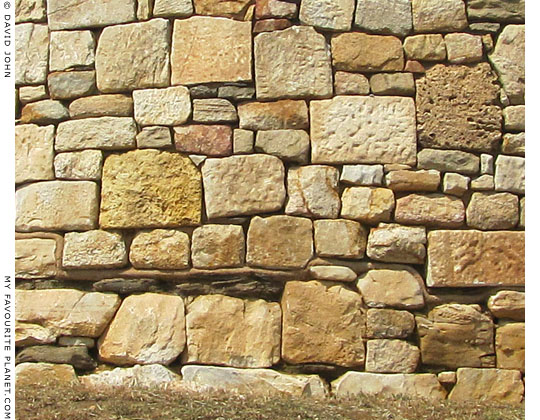|
|
| | My Favourite Planet > English > Europe > Greece > Macedonia > Stageira & Olympiada > Stageira gallery |
| Stageira & Olympiada |
Ancient Stageira gallery |
 |
 |
8 of 38 |
 |
 |
|
| |

The restored circular tower on the south wall of the Stageira acropolis. |
| |
The acropolis of Stageira, on the South Hill of the Liotopi peninsula, is at the highest point on the headland. The colonists from Andros and Chalcis built their first settlement in the 7th century BC on the peninsula's North Hill (see gallery pages 30-38).
By the end of the 6th century, at the beginning of the Classical era, the increase in population forced the Stageirites to expand their city to cover the South Hill and the valley between the two hills. Around 500 BC, as Stageira entered the height of its prosperity, building began to expand and improve the massive fortifications around the city, which were to reach a length of 2 km. The long south wall stretches over the brow of the South Hill, right across the width of the peninsula. Three other sections of wall around the headland, above the steep slopes down to the sea, follow the shape of the coastline (see map on the previous page).
Restoration work on the fortifications began in 1995, as part of a programme which included a wider study of the archaeological site by a group of architects. Excavations have so far uncovered the remains of three circular towers and several square towers around the walls.
The round tower in the photo above stands at the south-eastern corner of the acropolis enclosure (gallery pages 11-12), along the long south wall. |
|
|
| |

Detail of the restored stonework of the circular tower.
|
The classical walls and towers are built of several types of cut stone, including porous, limestone and marble, in a variety of colours, shapes and sizes.
The tower is constructed in layers made up of rows of larger stones interspersed with pairs of smaller stones on top each other to attain the same layer height.
The overall effect of the irregular stonework is pleasing to the eye, but seems a bit haphazard. However, such building required a great deal of planning, skill and hard work by masons and labourers, who worked on difficult terrain with primitive tools. |
|
| |
| |
| |
Photos, maps and articles: copyright © David John,
except where otherwise specified.
Additional photos: copyright © Konstanze Gundudis
All photos and articles are copyright protected.
Images and materials by other authors
have been attributed where applicable.
Please do not use these photos or articles without permission.
If you are interested in using any of the photos for your website,
project or publication, please get in contact.
Higher resolution versions are available on request.
My Favourite Planet makes great efforts to provide
comprehensive and accurate information across this
website. However, we can take no responsibility for
inaccuracies or changes made by providers of services
mentioned on these pages. |
| |
 |
Visit the My Favourite Planet Group on Facebook.
Join the group, write a message or comment,
post photos and videos, start a discussion... |
|
|
| |
|
|
| |
| |
 |
| |
 |
| |
 |
| |
 |
| |
George Alvanos
rooms in
Kavala's historic Panagia District
Anthemiou 35,
Kavala, Greece
kavalarooms.gr
|
| |
 |
| |
 |
| |
Olive Garden Restaurant
Kastellorizo,
Greece
+30 22460 49 109
kastellorizo.de
|
| |
Papoutsis
Travel Agency
Kastellorizo,
Greece
+30 22460 49 286
greeklodgings.gr
|
| |
|